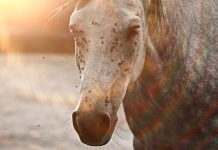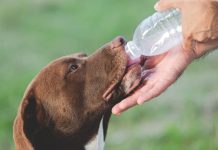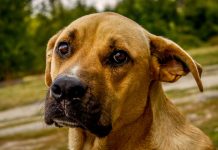Keeshond – these are really lively, “smiling” dogs, radiating positive and good mood! This can be confirmed by every owner of a shaggy wonder. Looking at the representatives of this breed, one might think that these are revived toys, which exist for this purpose, to amuse and give joy. However, history shows that these are by no means decorative dogs, but quite serious dogs that previously performed important tasks.
History

Data on the same type of livestock date back to 16-17 centuries. Then dogs with the same appearance, but different colors began to appear in different territories. For example, in the lands of modern Germany and Poland, and then it was Pomerania, two types of Spitz were widespread – largely white and medium-sized with red color.
Medium-sized gray and tan Spitz (this color was called wolf) were used as guards and were actively bred by Dutch and German breeders. Hence the two names for the breed – German Wolfspitz and Keeshond, the second name of the dog was received in Holland.
The early representatives of the breed did not have such an attractive appearance as modern dogs. And they were not particularly famous for other characteristics, for example, a strong grip, fast running, and other working qualities. Keeshond has always been “middle-class”, but they coped with the work of the guards, notifying the whole district about the invasion of strangers, grazed cattle, and were excellent companions.
Due to the fact that the dog handlers were not particularly interested in this breed and did not make high-bred animals out of dogs, Keeshonda puppies were available to everyone, and thanks to this they became widespread. Then people with little income did not allow themselves to keep dogs just like that, for the sake of communication, and even more so, to fulfill all the whims of pets. Therefore, rather Spartan living conditions and natural selection have turned the representatives of this breed into universal, unpretentious dogs.
This is how, without much standing out, the Spitz lived side by side with a person, until they nevertheless attracted the attention of breeders. They were indirectly involved in the Dutch revolution, which began in 1568 and lasted for more than a decade since the instigator of the first uprising had a Pomeranian named Guez in his pets. Subsequently, this dog turned into a symbol of the revolutionary movement, since the rebel Cornelius often appeared at various kinds of mass meetings with his pet.
Participants in the movement received the name “gezi”, which in translation sounded like half-breeds or mongrels. The revolution failed, and an order came from the authorities to destroy everything connected with the participants in the riots. The purges also affected the Spitz.
But, fortunately, this was not fully implemented, and at the turn of the 18th and 19th centuries, the first breed club appeared on the territory of Germany, whose members did a tremendous job and classified Spitz from various territories.
In 1899, the description of the representatives of the breeds, approved by the world clubs, appeared, and the breeding rules were formalized. Since this year, the Keeshond is considered officially recognized, although in Germany it continues to be called the Wolfspitz.
Description of the Keeshond Breed

There are international rules according to which a breed can only have one patronizing state. But the International Cynological Association unites all varieties of Spitz into a single standard in which they differ in height. There is one more description of Keeshond dogs, but already in the American Kennel Club.
Representatives of the breed have not only a unique, spectacular appearance but also sufficiently developed intellectual abilities. Having the appearance of a shaggy toy, the dogs are well developed and physically, they are very dexterous and tireless.
According to the standard characteristic, Keeshond is distinguished by friendliness and sociability, and this applies not only to humans but also to other animals.
If we talk about the dimensions of the representatives of this breed, then the ideal height for males is 45.7 cm at the withers, bitches are slightly smaller – 43.2 cm, although such parameters are not considered too important when evaluating dogs. At exhibitions, more attention is paid to the harmony of the physique and the presence of average strength. A pet should not have a heavy skeleton that catches the eye immediately, but a refined and graceful breed of Keeshond dogs should not be either. Moreover, the ideal size is estimated only for representatives over two years old.
The standards indicate the following data regarding appearance:
- The head should be medium-sized, proportional to the body, wedge-shaped. The skull is broad with a noticeable transition to the muzzle.
- The end of the muzzle is U-shaped, with neat lips, slightly taut, having a black coloration.
- The teeth are medium in size, create a dense row without gaps, the bite is correct. The lobe of the spout is small, rectangular, painted black.
- The dog has bulging, large, oval eyes (albeit with some mysterious slanting), with a lively shine and radiating sparks of mischief. The iris casts brown shades. The fit at the eyes is average. The eyelid tissue is black and dense.
- The ears are small, neat triangular in shape, but look miniature against the background of rich hair. They are in a standing position, have elastic cartilage, are widely spaced, have a high seating position, and are straight.
- The torso in dogs is more of a square format. The neck is strong, there is a pronounced bend. The withers are also well defined, however, due to the voluminous collar, this is not too noticeable. The back is of medium length, well-muscled, broad, with a moderately sloping croup.
- The belly is tucked up, but does not have a pronounced “undermining”.
- The front and hind limbs are proportional, have fairly strong developed joints, and are widely spaced. The legs are well-knit and rounded.
- The tail is set high, bent into a ring, which is located on the back, and pressed against it. A prerequisite is that the end of the tail must be black.
- The magnificent, chic coat is not for nothing called the hallmark of the Keeshond. It is well developed, very thick and dense, with a soft, rich undercoat. The outer hair is upright and coarser. Thoroughbred representatives can boast of an abundance of chic fur on the face in the form of sideburns, a thick collar in the neck and chest, as well as in the back and tail. The adherent coat is present only on the front of the limbs and on the nose.
Color

The color of Keeshond is not so simple: if we talk about the general palette, then there are two colors – gray and black. The standard allows the presence of tan markings of any gray shade, other colors are a disadvantage.
The color of the undercoat ranges from any shades of gray to cream. The guard hairs have a light base and a dark tip. The overall color of a dog is directly related to the intensity of the dark color. The presence of black “glasses” is mandatory on the face, and the ears are also painted in the same color. The coat in the breeches, muff, and chest has a more light tone, as well as the back of the tail. The feet are cream-colored.
As for the evaluation at the exhibitions, the experts pay attention to the natural beauty of the animal, it is allowed to process wool only on the lips and limbs, and then, if it is required. A trimmed Keeshond will not be allowed to the show and, moreover, may be excluded from breeding.
Education and Training

These cute and funny dogs are smart enough and have remarkable intelligence, so they are very easy to learn, and their curiosity only speeds up this process. On the territory of the Netherlands, representatives of this breed are assigned an important role of companions, with which they do an excellent job. That is why the training of these pets is often limited to commands that are of an entertaining nature, rather than bringing practical benefits.
Keeshonds are constant participants in various exhibitions and are very popular there, but ordinary dog lovers also create them with increased attention and love. Which, in general, is not surprising, with such and such an attractive appearance and docile character.
But the German Wolfspitz gets a slightly different upbringing. In Germany, these dogs are used as watchdogs, so they take special courses in the skills of protecting property and families. Here the dogs learn to keep strangers away until the owner permits it. What does this mean? And the fact that the representatives of this breed have a rather flexible character, and it depends only on the owner which pet will receive education and skills.
Personality

Keeshond is one of the few breeds bred not for hunting or service, for centuries they have been exclusively companion dogs.
They are loving and truly value communication with a person. This is a good-natured and cheerful companion, especially loving children and any time with his family.
For him, being close to loved ones is the most important thing in life. They are called the shadow of their master, but at the same time, they are equally attached to all family members and love everyone at once, without giving preference to one or the other.
Compared to other German Spitz, Keeshondas are calmer, less dominant, and very affectionate. Even if there are other people in the room, but the owner left it, the dog will sit and wait for him to return. They have a highly developed intuition and they feel the mood of a person, they are excellent guides for the blind and perform well in agility and obedience.
Throughout their history, they have been popular as guard dogs, as they have loud and resonant barks. They remain so today, the keeshond will always warn the owner about guests or strange activity. Wolfspitz is watchful and loud, but not aggressive towards humans, most often the opposite.
All they do is bark, but keep in mind that such barking can annoy your neighbors. Especially if the dog remains without communication with the owner for a long time and begins to bark from stress. True, with proper training, it can be weaned from uncontrollable barking.
In his book The Intelligence of Dogs, Stanley Coren calls them a great breed, referring to their ability to learn new commands, and puts it 16th in terms of intelligence.
To do this, they need from 5 to 15 repetitions, and they obey in 85% of cases or more. Most believe that Keeshondas are smart and loving, and this automatically makes them the ideal family dog, and also easily trained.
Yes, they are great for families, but only for those who have experience of keeping other breeds and get along with each other. Like other independent thinking breeds, Keeshondas respond extremely poorly to rough training methods.
This is a sensitive breed of dog that reacts more sharply to loud sounds and does not get along well in families where they often shout and sort things out.
Keeshonds learn quickly if their owners are consistent, polite, and calm. For them, the owner must be the leader of the pack who governs and directs their lives.
Dogs understand the strength of the owner on an instinctive level and this breed is no exception.
They learn quickly, both good and bad. An attempt to change undesirable behavior using rude methods will lead to negative changes in the character of the dog, making it nervous, fearful, and frightened. These dogs need to be trained gently and patiently, without straining or screaming.
If your dog is having problems with behavior, then be prepared for endless barking, chewed shoes, spoiled furniture. Most of these problems stem from resentment, boredom, or lack of communication with the owner.
If the puppy has not grown into a controlled dog, then these smart little beasts can entertain themselves, and often such entertainment is destructive.
It is necessary to raise a puppy not in fear, but in respect of the person. They want to please and please their family, so when the dog doesn’t obey, you just need to be patient, not rude.
And yes, for those who want to keep a dog in an aviary or in the yard, this breed will not work. They need constant contact with people and activity to stay happy.
As with any breed, the sooner the puppy is socialized, the better. Introduce him to new people, situations, animals. This will help the puppy develop into a calm and balanced dog.
They already get along well with children, well with other animals, so socialization is needed not in order to reduce aggression, but in order to avoid fearfulness and timidity.
Unlike many other breeds that tend to be aggressive, the Keeshond is overly loving and must understand when enough is enough, even when it comes to love.
This is a playful dog that requires daily play and long walks, preferably with the whole family. The breed is recommended for active families who will take the dog with them everywhere. It doesn’t matter if it’s walking, cycling, fishing – Keeshondu is interested everywhere if the family is nearby.
They are ideal for agility and obedience, moreover, such activity is recommended, as it loads the dog physically and intellectually.
Activity, exertion, and fatigue can help the dog get rid of its behavior problems.
Wolfspitz is able to get along anywhere, from an apartment to a private house, if only with a family. True, they feel better in cool climates, they do not like high temperatures and humidity.
Care and Maintenance

Like most Spitz breeds, it has a luxurious coat, but grooming is not as tedious as one might expect. Daily brushing keeps your dog beautiful and well-groomed, and the house is clean of dog hair.
Dogs shed moderately throughout the year, but the undercoat sheds profusely twice a year, in spring and autumn. At this time, it is advisable to brush the dog more often to avoid tangles.
A thick coat protects from cold and sun, so trimming is not recommended. Keeshonds are not prone to the smell of dogs and often bathing is not necessary or recommended for them, usually, they are washed only when necessary.
Health

It is a healthy breed with an average life span of 12-14 years. They are prone to obesity, so proper, moderate feeding and regular exercise are important for the dog’s health.































